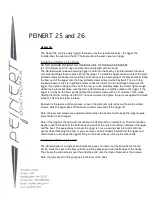
9. Anchoring & the windlass
Setting your anchor:
Preparation:
•
Establish a non verbal communication system from bow to stern, as with
the noise of the engine and wind, verbal communication proves difficult.
•
Tie the dinghy painter close to the boat at the bow or amidships to avoid
wrapping it around the prop.
Location:
•
Choose a clear area to anchor in, normally in 12 to 25 feet. A white
bottom is sand and perfect for anchoring. A brown or green bottom will be
grass, rock or coral. Only anchor in sand.
•
Make sure that you are not on a lee shore; i.e. that the land mass is
protecting you from the elements and that you are not being pushed onto
the shore. A lee shore is the most dangerous place to anchor your
yacht.
Action:
•
Manually lift the anchor over the bow roller and feed the chain so the
anchor is just above the water surface.
•
Use the elements; approach from down wind or current, whichever
prevails.
•
Once the yacht is stationary use the electric windlass to drop the anchor.
The elements will push you back and away from the anchor.
•
Minimum scope is 5:1. In heavy weather you may want to increase that,
always ensuring your swing area is clear of any obstacles.
•
Engage reverse, slowly building up to 1500 rpm to really drive your hook
into the sand.
•
Once set, put the engine in neutral and allow the yacht to settle, take
transits around the bay to ensure you are not dragging, it is always
advisable to snorkel the anchor and ensure it is bedded in correctly and
not just lying on its side.
Attaching the snubbing line:
•
Once you are happy that the anchor is set you must attach the snubbing
line. The snubbing line protects the windlass and it is important that you
attach the snubber every time you set the anchor.
•
Attach the hook around the chain link (the hook is too big to go though
the link) and cleat off the bitter end of the line to a bow cleat. Pay out
enough chain so that the snubbing line becomes taut.
•
If the hook falls of the chain it means that there is not enough tension on
the line. In this case re-attach the hook and pay out more chain until the
line is once again taut.
Setting a secondary anchor:
•
If a second anchor is required, e.g. you are anchoring in a mooring field
and need to control your swing room, deploy the primary as above and
attach the secondary at the bow. Drive the boat forward at a 45 degree
angle to the primary. Once in line with the primary deploy the secondary
and allow the elements to push you back. Increase astern to 1500 rpm to
drive in the secondary. Snorkel over the anchor to ensure a good hold.













































